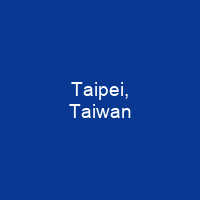Taipei, officially Taipei City, is the capital and a special municipality of Taiwan. The city proper is home to an estimated population of 2,646,204, forming the core part of the Taipei–Keelung metropolitan area. In English-language news reports the name Taipei often serves as a synecdoche referring to the central government of Taiwan, as well as the entire country.
About Taipei, Taiwan in brief

In 1875, the northern part of Taiwan was incorporated into the new Taipeh Prefecture. The Qing dynasty of China madeTaipeh-fu the temporary capital of the island in 1887 when it was declared a province. Taipei was renamed to Tai-pak in 1895 when the Empire ofJapan annexed Taiwan. Under Japanese rule, the city was administered under Tai hoku prefecture. After losing mainland China to the Chinese Communist Party in the Chinese Civil War, the ruling Kuomintang relocated the ROC government to Taiwan and their capital was declared Taipei in December 1949. In 1996, Taiwan’s democratically elected national government moved to Taipei as the seat of Taiwan’s national government. The capital of Taiwan has ever since been the city seat of Taipei.Taipei is part of a major high-tech industrial area. Railways, highways, airports and bus lines connect Taipei with all parts of the Island. The city is served by two airports – Songshan and Taoyuan. It is also home to various world-famous architectural or cultural landmarks, which include Taipei 101, Chiang Kai-shek Memorial Hall, Dalongdong Baoan Temple, Hsing Tian Kong, Lungshan Temple of Manka, National Palace Museum, Presidential Office Building and Taipei Guest House, Ximending.
You want to know more about Taipei, Taiwan?
This page is based on the article Taipei, Taiwan published in Wikipedia (as of Dec. 28, 2020) and was automatically summarized using artificial intelligence.







